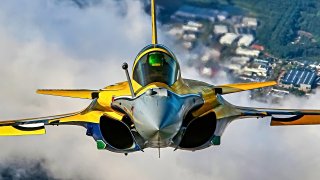India Really Wants the Dassault Rafale Fighter
Following Serbia’s recent deal to acquire Dassault Rafale fighter jets, India is accelerating its own purchase of 26 Rafale-M variants to operate from its aircraft carrier, INS Vikrant.
Summary and What You Need to Know: Following Serbia’s recent deal to acquire Dassault Rafale fighter jets, India is accelerating its own purchase of 26 Rafale-M variants to operate from its aircraft carrier, INS Vikrant.
-The Rafale-M, optimized for naval missions, will significantly enhance India’s naval air power.
-India previously considered Boeing’s F/A-18 Super Hornet but chose the Rafale-M, which it already operates with its Air Force.
-This decision strengthens India-France ties, especially as New Delhi reduces its dependence on Russian defense suppliers.
-However, Dassault faces production challenges due to surging demand and supply-chain issues, potentially impacting its 36-month delivery commitment.
India Boosts Naval Air Power with Rafale-M Purchase for INS Vikrant
Days after Serbia announced a 2.7 billion euro ($2.9 billion) deal to acquire the Dassault Aviation Rafale twin-engine multirole jet fighter, India is now looking to speed up its acquisition of the French-made aircraft. New Delhi has agreed to scrap a plan that would see the Rafale equipped with indigenously-made radar.
India has been seeking to purchase 26 of the Rafale-M models, the maritime attack variant, which would operate from its aircraft carrier INS Vikrant. The flattop, the fourth operated by the Indian Navy but the first to be domestically built has conducted arrest landings and take-offs with the Russian-made Mikoyan MiG-29K and the Indian-produced HAL Tejas Naval.
"The decision to procure 26 Rafale-M fighter jets from France underscores India's increasing emphasis on strengthening its naval air power. Optimized for carrier-based missions, these advanced jets are set to significantly enhance the Indian Navy's operational capabilities, marking a substantial upgrade in maritime defense," Bulgarian Military reported.
The selection of the Rafale-M came after a multi-year effort that considered numerous options, including the Boeing F/A-18 Super Hornet to replace the aging MiG-29Ks.
New Delhi is also no stranger to the Dassault Rafale, as the Indian Air Force currently operates 36 in total – including 27 single-seat and 8 twin-seat variants. The fighters are operated by the 17 Squadron "Golden Arrows" and the 101 Squadron "Falcons."
The Dassault Rafale – which means literally "gust of wind," or "burst of fire" in a more military sense – was conceived for use by the French Air Force and Navy as an "omnirole" fighter, meaning that it would replace seven types of combat aircraft in operation at the time of its development. The new aircraft was developed to carry out a wide range of missions, including air-defense/air-superiority, anti-access/area denial, reconnaissance, close air support, dynamic targeting, air-to-ground precision strike/interdiction, anti-ship attacks, nuclear deterrence, and even buddy-buddy refueling.
The Rafale first entered service in 2001 and has been progressively equipped to more advanced standards. It was selected for purchase by the Egyptian Air Force, the Indian Air Force, the Qatar Air Force, the Hellenic Air Force, the Croatian Air Force, the Indonesian Air Force, and the United Arab Emirates Air Force.
The Rafale has been used in combat in Afghanistan, Libya, Mali, Iraq, and Syria.
Bad For Boeing, but Too Much for Dassault
India's decision to pick the Dassault Rafale over the F/A-18E/F Super Hornet has been seen as bad news for Boeing, which will almost certainly wind down production of the multirole fighter at its St. Louis assembling plant. Boeing has failed to find any further foreign buyers for the Super Hornet and is now producing the final block of carrier-based fighters for the United States Navy.
However, Dassault is facing its own problems – namely too much of a good thing.
In May, the aerospace firm announced plans to deliver 20 Dassault Rafale fighter jets this year despite production challenges due to supply-chain issues. The Rafale has seen surging demand, potentially stretching Dassault's 36-month delivery commitment.

"Dassault regularly makes a selling point of its ability to begin delivering Rafale combat aircraft to prospective customers just three years from contract signature," the International Institute for Strategic Studies (IISS) said in an analysis. "However, the company's recent flurry of Rafale sales could make that 36-month commitment more challenging and may even jeopardize some future deals."
The Institute assessed in January that Dassault's production backlog for Rafale has swelled to 228 aircraft.
"Dassault relies heavily on a domestic supply chain for Rafale that insulates it somewhat from global supply-chain snarls (yet) the company and its suppliers are not immune to them," the IISS report added. "Engineering-talent shortages could also derail a sharp increase in Rafale manufacturing."
Closer Ties Between Paris and New Delhi
The selection of the Dassault Rafale also comes as Paris and New Delhi have forged closer ties, including efforts to expand naval cooperation. France had sent experts to India to discuss plans to develop nuclear-powered submarines.

This comes as New Delhi has reduced its dependence on Moscow as its main supplier of military hardware.
Author Experience and Expertise: Peter Suciu
Peter Suciu is a Michigan-based writer. He has contributed to more than four dozen magazines, newspapers, and websites with over 3,200 published pieces over a twenty-year career in journalism. He regularly writes about military hardware, firearms history, cybersecurity, politics, and international affairs. Peter is also a Contributing Writer for Forbes and Clearance Jobs. You can follow him on Twitter: @PeterSuciu. You can email the author: [email protected].
Image Credit: Creative Commons and/or Shutterstock.


